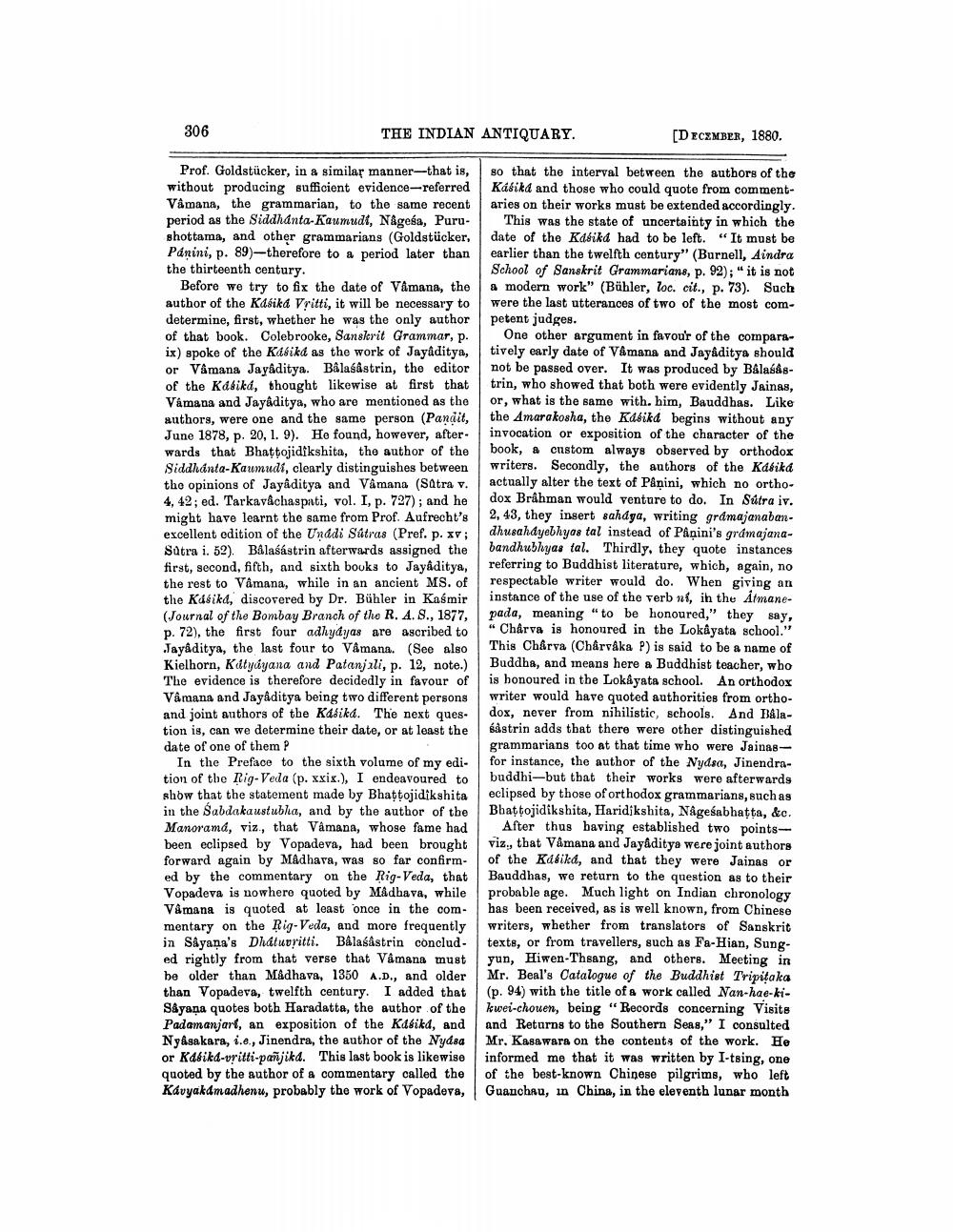________________
306
THE INDIAN ANTIQUARY.
[DECEMBER, 1880.
Prof. Goldstücker, in a similar manner-that is, without producing sufficient evidence-referred Vâmana, the grammarian, to the same recent period as the Siddhanta-Kaumudi, Någesa, Purushottama, and other grammarians (Goldstücker, Panini, p. 89)--therefore to a period later than the thirteenth century.
Before we try to fix the date of Våmana, the author of the Kasika Vritti, it will be necessary to determine, first, whether he was the only author of that book. Colebrooke, Sanskrit Grammar, p. ix) spoke of the Kasiká as the work of Jayaditya, or Vamana Jayaditya. Balasastrin, the editor of the Kabikd, thought likewise at first that Vámana and Jayaditya, who are mentioned as the authors, were one and the same person (Pandit, June 1878, p. 20, 1. 9). He found, however, after wards that Bhattojidikshita, the author of the Siddhanta-Kaumuds, clearly distinguishes between the opinions of Jayaditya and Vamana (Satra v. 4, 42; ed. Tarkavachaspati, vol. I, p. 727); and he might have learnt the same from Prof. Aufrecht's excellent edition of the Unádi Sútras (Pref. p. XV; Sutra i. 52). Balaśástrin afterwards assigned the first, second, fifth, and sixth books to Jayaditya, the rest to Vamana, while in an ancient MS. of the Kasika, discovered by Dr. Bühler in Kasmir (Journal of the Bombay Branch of the R. A. 8., 1877, p. 72), the first four adhyayas are ascribed to Jayaditya, the last four to Vamana. (See also Kielhorn, Katyayana and Patanjali, p. 12, note.) The evidence is therefore decidedly in favour of Vamana and Jayaditya being two different persons and joint authors of the Kadika. The next ques. tion is, can we determine their date, or at least the date of one of them P
In the Preface to the sixth volume of my edi- tion of the Rig Veda (p. xxix.), I endeavoured to show that the statement made by Bhattojidikshita in the Sabdakaustubha, and by the author of the Manorama, viz., that Vamana, whose fame had been eclipsed by Vopadeva, had been brought forward again by Madhava, was so far confirmed by the commentary on the Rig Veda, that Vopadeva is nowhere quoted by Madhava, while V&mana is quoted at least once in the commentary on the Rig Veda, and more frequently in Sâyana's Dhatuvritti. Bâlaśåstrin conclud. ed rightly from that verse that Vamana must be older than Madhava, 1350 A.D., and older than Vopadeva, twelfth century. I added that Såyana quotes both Haradatta, the author of the Padamanjart, an exposition of the Kafikd, and Nyasa kara, i.e., Jinendra, the author of the Nydea or Kafikd-vritti-pañjikd. This last book is likewise quoted by the author of a commentary called the Kavyakamadhenu, probably the work of Vopadeva,
so that the interval between the authors of the Kubikd and those who could quote from commentaries on their works must be extended accordingly.
This was the state of uncertainty in which the date of the Kdsikd had to be left. “It must be earlier than the twelfth century" (Burnell, Aindra School of Sanskrit Grammarians, p. 92):" it is not a modern work" (Bühler, loc. cit., p. 73). Such were the last utterances of two of the most competent judges.
One other argument in favour of the comparatively early date of Vamana and Jayaditya should not be passed over. It was produced by Balabastrin, who showed that both were evidently Jainas, or, what is the same with him, Bauddhas. Like the Amarakosha, the Katika begins without any invocation or exposition of the character of the book, a custom always observed by orthodox writers. Secondly, the authors of the Katika actually alter the text of Pånini, which no orthodox Brůhman would venture to do. In Sútra iv. 2, 43, they insert sahdya, writing gramajanabandhusahdyebhyas tal instead of Påņini's gramajanabandhubhyas tal. Thirdly, they quote instances referring to Buddhist literature, which, again, no respectable writer would do. When giving an instance of the use of the verb nf, in the Atmanepada, meaning "to be honoured," they say, " Charva is honoured in the Lokayata school." This Charva (Chårvåka P) is said to be a name of Buddha, and means here a Buddhist teacher, who is honoured in the Lokayata school. An orthodox writer would have quoted authorities from orthodox, never from nihilistic, schools. And Bålasåstrin adds that there were other distinguished grammarians too at that time who were Jainasfor instance, the author of the Nydsa, Jinendrabuddhi--but that their works were afterwards eclipsed by those of orthodox grammarians, such as Bhattojidikshita, Haridikshita, Någesabhatta, &c.
After thus baving established two pointsviz, that Vamana and Jayaditya were joint authors of the Kalikd, and that they were Jainas or Bauddhas, we return to the question as to their probable age. Much light on Indian chronology has been received, as is well known, from Chinese writers, whether from translators of Sanskrit texts, or from travellers, such as Fa-Hian, Sungyun, Hiwen-Thsang, and others. Meeting in Mr. Beal's Catalogue of the Buddhist Tripitaka (p. 94) with the title of a work called Nan-hae-kikwei-chouen, being "Records concerning Visite and Returns to the Southern Seas," I consulted Mr. Kasawara on the contents of the work. He informed me that it was written by I-tsing, one of the best-known Chinese pilgrims, who left Guanchau, in China, in the eleventh lunar month




